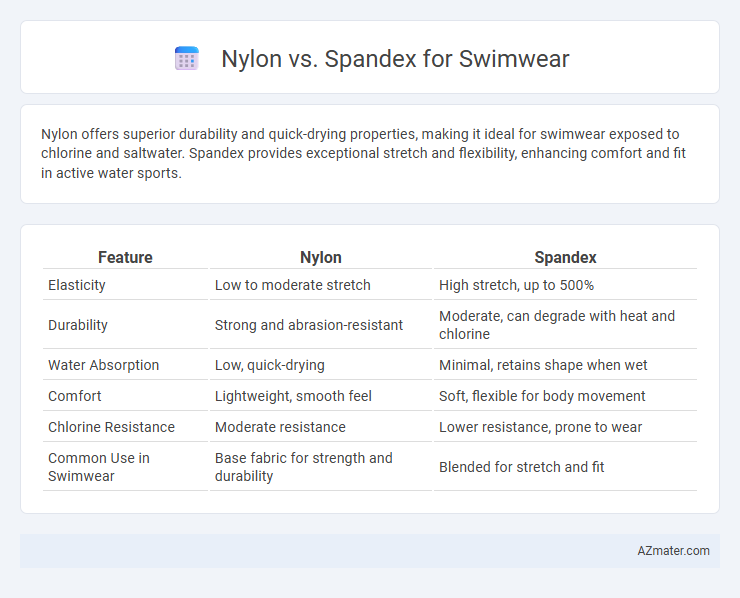Nylon offers superior durability and quick-drying properties, making it ideal for swimwear exposed to chlorine and saltwater. Spandex provides exceptional stretch and flexibility, enhancing comfort and fit in active water sports.
Table of Comparison
| Feature | Nylon | Spandex |
|---|---|---|
| Elasticity | Low to moderate stretch | High stretch, up to 500% |
| Durability | Strong and abrasion-resistant | Moderate, can degrade with heat and chlorine |
| Water Absorption | Low, quick-drying | Minimal, retains shape when wet |
| Comfort | Lightweight, smooth feel | Soft, flexible for body movement |
| Chlorine Resistance | Moderate resistance | Lower resistance, prone to wear |
| Common Use in Swimwear | Base fabric for strength and durability | Blended for stretch and fit |
Introduction: Nylon vs Spandex in Swimwear
Nylon and spandex are two key materials commonly used in swimwear, each offering distinct advantages. Nylon provides durability, quick-drying properties, and resistance to abrasion, making it ideal for swimwear exposed to water and sun. Spandex, known for its exceptional elasticity and shape retention, ensures a snug fit and freedom of movement essential for active swimmers.
Material Composition and Properties
Nylon offers exceptional strength, durability, and quick-drying properties, making it a popular choice for swimwear that requires resilience and lightweight comfort. Spandex, also known as Lycra or elastane, is prized for its superior elasticity and ability to retain shape, providing swimwear with optimal stretch and flexibility. Combining nylon with a percentage of spandex enhances both durability and stretch, resulting in swimwear that fits snugly while allowing unrestricted movement in water.
Comfort and Flexibility Comparison
Nylon provides a smooth, lightweight feel with excellent durability, making it comfortable for prolonged swimwear use, while spandex offers exceptional stretch and shape retention, enhancing flexibility during movement. Swimwear blends often combine nylon's moisture-wicking properties with spandex's elasticity to optimize both comfort and freedom of motion. The higher spandex content results in better stretchability and a snug fit, crucial for active water sports, whereas nylon-dominant fabrics emphasize quick drying and abrasion resistance.
Durability in Chlorinated and Saltwater
Nylon swimwear offers exceptional durability in both chlorinated pools and saltwater environments, maintaining fabric integrity and color over extended use. Spandex provides superior stretch and flexibility but tends to degrade faster when exposed to chlorine, resulting in reduced lifespan and elasticity. For long-lasting swimwear performance in harsh aquatic conditions, nylon blends with a small percentage of spandex optimize durability and comfort.
UV Resistance and Sun Protection
Nylon swimwear offers moderate UV resistance but tends to degrade faster under prolonged sun exposure compared to spandex, which provides superior elasticity and better long-term protection against harmful UV rays. Spandex blends in swimwear enhance sun protection by maintaining fabric integrity and preventing UV penetration, making it ideal for extended outdoor activities. Fabrics combining both nylon and spandex create a balanced swimwear material that resists UV damage while ensuring comfort and flexibility in the sun.
Fit and Shape Retention
Nylon offers excellent durability and a smooth fit for swimwear while maintaining shape retention even after extended water exposure. Spandex provides superior stretch and flexibility, ensuring a snug and comfortable fit that contours to the body. Combining nylon with spandex enhances swimwear's overall elasticity and resilience, optimizing fit and shape retention during active use.
Breathability and Drying Time
Nylon swimwear offers excellent breathability due to its lightweight and moisture-wicking properties, allowing for better air circulation and reduced heat retention. Spandex, while providing superior stretch and flexibility, tends to trap moisture and dries more slowly compared to nylon. Prioritizing quick-drying fabric, nylon is often preferred for swimwear where breathability and rapid drying time are essential.
Color Retention and Fade Resistance
Nylon swimwear excels in color retention due to its strong synthetic fibers, maintaining vibrant hues even after prolonged sun exposure and repeated chlorinated water contact. Spandex offers superior stretch and comfort but tends to fade faster under UV rays and harsh chemicals without specialized treatments. Combining nylon with spandex blends often delivers enhanced durability and fade resistance while preserving elasticity, making them ideal for long-lasting swimwear.
Cost Considerations: Nylon vs Spandex
Nylon swimwear typically offers a lower cost compared to spandex, making it a budget-friendly option for consumers seeking durability and quick-drying properties. Spandex, known for its exceptional elasticity and shape retention, often comes at a higher price point due to its advanced fabric technology. Evaluating cost considerations between nylon and spandex involves balancing affordability with performance features essential for swimwear.
Which Is Better for Swimwear?
Nylon offers superior durability, quick-drying capabilities, and excellent resistance to chlorine, making it a popular choice for swimwear that maintains shape and color over time. Spandex provides exceptional stretch and flexibility, allowing for a snug, comfortable fit that enhances movement in the water. Combining nylon with spandex creates swimwear that balances strength, elasticity, and comfort, with blends typically ranging from 70-90% nylon and 10-30% spandex for optimal performance.

Infographic: Nylon vs Spandex for Swimwear
 azmater.com
azmater.com